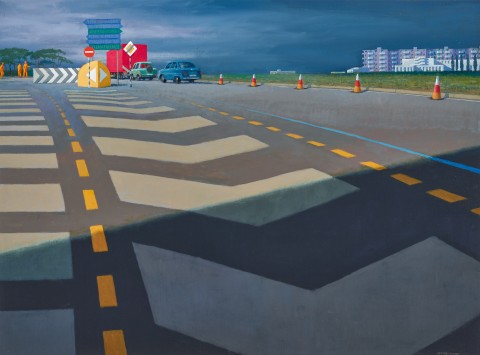DIVERSION FOR SIENA, 2002 – 03
JEFFREY SMART
oil on canvas
85.0 x 115.0 cm
signed lower right: JEFFREY SMART
Australian Galleries, Sydney (label attached verso)
Private collection, Perth, acquired from the above in 2003
Jeffrey Smart: Paintings and Studies 2002 – 2003, Australian Galleries, Sydney, 23 September – 18 October 2003, cat.3 (illus.)
The Cleaners, 2004, illus. in Pearce, B., Master of Stillness: Jeffrey Smart, Wakefield Press, Adelaide, 2012, p.105
We are grateful to Stephen Rogers, Archivist for the Estate of Jeffrey Smart, for his assistance with this catalogue entry.
Jeffrey Smart once told me he aimed to make plain-speaking paintings that refreshed the eye while entertaining the inquisitive mind. He also talked of civic progress and modernisation as his enduring subjects, the artist having watched the systematic reconstruction of Italy, a crippled nation in ruins when he first arrived there after the Second World War.
Those artistic qualities, and that driving theme, intersect in Diversion for Siena 2002 – 03 which shows a corner of present-day rural Tuscany. A road sign within the picture may indicate directions to historic towns including Arezzo, Siena and Florence, although what we see smacks of efficiency and modernity. Visually, Smart’s painting is fixed on a section of one of the autostrada which now criss-cross a previously inefficient country, enabling quick economical travel and communication. Suggestions of ongoing roadwork feature in middle ground. A container truck and two Italian-manufacture cars are queued to the right, these stationary vehicles being offset by a trio of workmen busy at the left. Further back, the artist shows in distance a group of smart modern apartment buildings on the right, balancing them to the left with a typical stand of Mediterranean umbrella pines.
In his best mature paintings Jeffrey Smart always played visual games, confident his viewers would delight in hunting for sequences in geometry, proportion and colour. Diversion for Siena is rich in this characteristic visual wit. Colours of vehicles alternate; so do the shapes of two traffic signs (circle, diamond); then there are five coloured traffic cones rhyme with the orange boiler suits the other side of the work; while contrasted patterns of road markings (directional arrows, dashes, straight lines) are used to excess. Of course, the dominant curve of the roadway, indeed, all the principal lines in the painting’s design, lead the eye to three large shapes in bright colours set in the upper left: a yellow junction divider, a blue road sign with green bands, and a red freight container. Ever playing his witty games, Smart even has the white arrows on a temporary barrier point out those main shapes.
It is usual when discussing Jeffrey Smart to emphasise his indebtedness to Renaissance masters, especially to Piero della Francesca, a native Tuscan who excelled at integrating complex geometry into his pictures. We can see Smart following in his creative hero’s footsteps with that easy arc of the autostrada, which employs the famed ‘Golden Mean’. Lesser talents would struggle to calculate then accurately plot out this curve, let alone the many highway markings set on it, but Smart’s handling is effortless. He literally is a modern master.
Mind you, those striping patterns upon the road underscore the title: Diversion for Siena. In our conversations, Smart would point to how he slipped into his later pictures sly visual references recognised by locals and visitors. those who have been to Siena will spot his cryptic allusion in this painting, because above the historic hilltop town sits a striking sight: an Italian-Gothic cathedral with stonework of alternating light and dark stripes. Once seen that distinctive pattern is not forgotten. It is synonymous with Siena, which since medieval times has had a white bar over a black bar for its coat of arms. So as you walk around the town white and dark bands can be found everywhere, from the interior decor and frescoes in heritage buildings through to traditional crucifixes worn by pilgrims using St Catherine of Siena’s chapel.
No wonder Diversion for Siena has such an excess in white and dark geometric bands indicating the way to Siena. Jeffrey Smart, a long-time resident of Tuscany, is sharing a clever coded message with knowing viewers.
DR CHRISTOPHER HEATHCOTE
